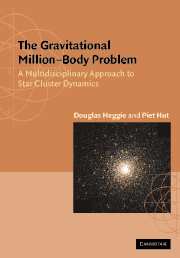Book contents
- Frontmatter
- Contents
- Preface
- PART I INTRODUCTIONS
- PART II THE CONTINUUM LIMIT: N → ∞
- PART III MEAN FIELD DYNAMICS: N = 106
- PART IV MICROPHYSICS: N = 2
- PART V GRAVOTHERMODYNAMICS: N = 106
- PART VI GRAVITATIONAL SCATTERING: N = 3
- PART VII PRIMORDIAL BINARIES: N = 4
- 24 Binaries in Star Clusters
- 25 Triple Formation and Evolution
- 26 A Non-Renewable Energy Source
- PART VIII POST-COLLAPSE EVOLUTION: N = 106
- PART IX STAR CLUSTER ECOLOGY
- Appendix A A Simple N-Body Integrator
- Appendix B Hints to Solution of Problems
- References
- Index
26 - A Non-Renewable Energy Source
Published online by Cambridge University Press: 05 June 2012
- Frontmatter
- Contents
- Preface
- PART I INTRODUCTIONS
- PART II THE CONTINUUM LIMIT: N → ∞
- PART III MEAN FIELD DYNAMICS: N = 106
- PART IV MICROPHYSICS: N = 2
- PART V GRAVOTHERMODYNAMICS: N = 106
- PART VI GRAVITATIONAL SCATTERING: N = 3
- PART VII PRIMORDIAL BINARIES: N = 4
- 24 Binaries in Star Clusters
- 25 Triple Formation and Evolution
- 26 A Non-Renewable Energy Source
- PART VIII POST-COLLAPSE EVOLUTION: N = 106
- PART IX STAR CLUSTER ECOLOGY
- Appendix A A Simple N-Body Integrator
- Appendix B Hints to Solution of Problems
- References
- Index
Summary
As we have seen, primordial binaries exist in some abundance in globular clusters, and so there is good reason to study the behaviour of a million-body problem in which there are many binaries. How do such clusters evolve?
To some extent the binaries may be treated as heavy point masses, provided we are interested in interactions with other stars at distances much greater than the typical semi-major axis of a binary. Thus the binaries behave like a heavy species, and the process of mass segregation (Chapter 16) ensures that they become heavily concentrated towards the core of the cluster. It follows that, even if we start with a cluster in which only ten per cent of the stars are binaries, we quickly find ourselves looking at part of the system (the core) where the abundance of binaries is more like 90%. Incidentally, it has even been argued that young star clusters may consist entirely of binaries. For one reason or another, then, the study of stellar systems in which essentially all stars are binaries is an important one.
Something was already said about the interaction between two binaries in the previous chapter. There we quickly focused on the formation of hierarchical triple systems in such encounters. In the present chapter we focus on the energetics of these interactions. We shall see in the next chapter that this is the main way in which these interactions feed back into the overall dynamics of a stellar system.
- Type
- Chapter
- Information
- The Gravitational Million–Body ProblemA Multidisciplinary Approach to Star Cluster Dynamics, pp. 246 - 252Publisher: Cambridge University PressPrint publication year: 2003



